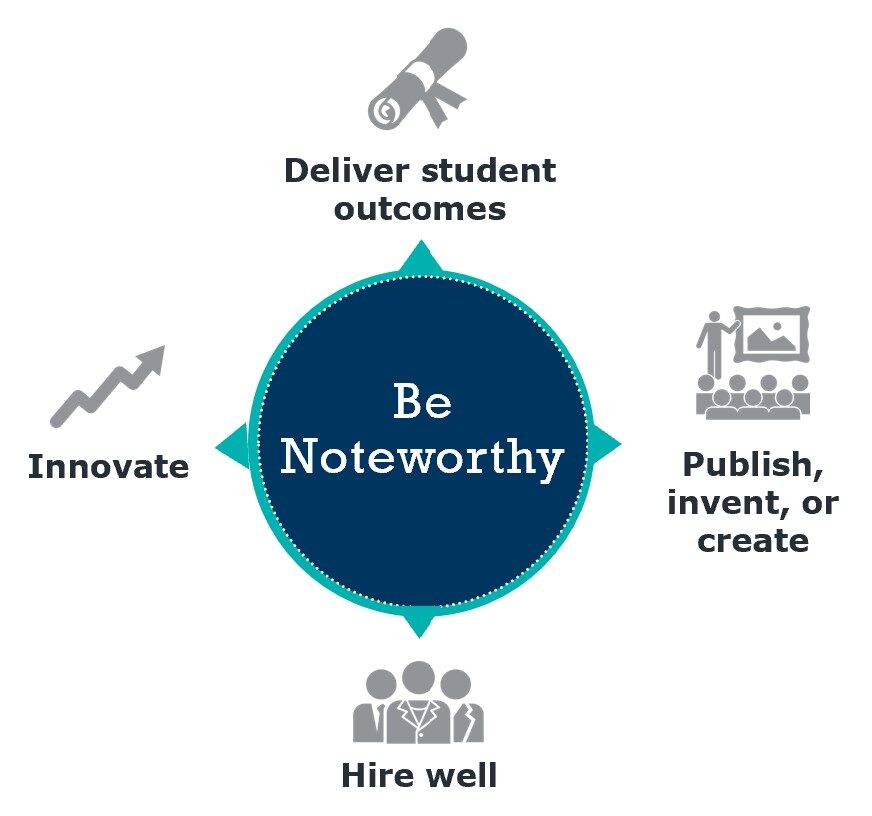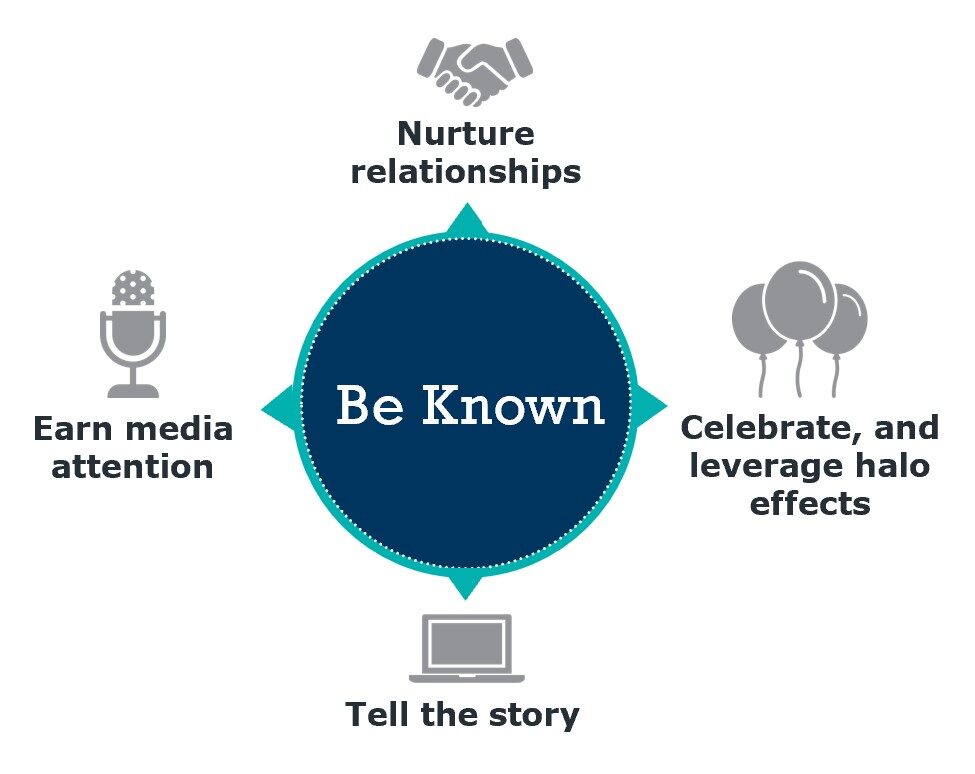Here’s how to improve your graduate program rankings
During my time as the Dean of the F. W. Olin Graduate School of Business at Babson College, the school maintained its ranking as the #1 graduate school for entrepreneurship in U.S. News and World Report, a spot they still hold. In my nearly three years as Dean of Graduate and Adult Learner Recruitment at EAB, many of our partner schools have asked for advice on how to move up in the rankings. Below are three lessons for graduate enrollment leaders looking to improve their school’s rankings.
Lesson 1: Learn How Your Rankings Work
Each higher education ranking system has its own quirks, priorities, and approach to measurement. Each system takes different criteria into account and uses a unique formula to calculate their rankings. In many cases, one ranking source will even have a different methodology for different disciplines and program types.
Submitting your information to be considered for the rankings is no small task. Finding, compiling, and reporting all the data to the evaluators is often a significant time investment. As such, it is crucial that you identify which ranking(s) you have the most affinity for so you don’t waste valuable time applying for those that will not help your institution or program in the long run. It is likely that your programs will perform better in some rankings systems than in others based on the varied methodology.
U.S. News and World Report Ranking Methodology Percentage
| U.S. News and World Report Ranking Methodology | Percentage |
|---|---|
| Graduation and Retention Rates | 22% |
| Undergraduate and Academic Reputation | 20% |
| Faculty Resources | 20% |
| Financial Resources per Student | 10% |
| Graduation Rate Performance | 8% |
| Student Selectivity | 7% |
| Social Mobility | 5% |
| Graduate Indebtedness | 5% |
| Average Alumni Giving Rate | 3% |
Accuracy is key when it comes to rankings. Knowing these formulas thoroughly can help you avoid mistakes or omissions, and it is a good idea to find help on campus to ensure the validity of the data, since any inaccuracies can significantly complicate and lengthen the process. When in doubt, I suggest reaching out to the ranking authority to ask for guidance on how to submit and what to submit.
Lesson 2: Focus on the Variables That Will Support Your Program’s Long-Term Goals
The variables most commonly used for rankings can be divided into three categories: those related to program inputs, program outputs, and reputation.
Inputs
- Student quality
- Selectivity
- Faculty quality
- Resources
Outputs
- Employment
- Salaries
- Test-pass rates
- Student satisfaction
- Alumni satisfaction
- Research output
Reputation
- Peer assessments
- Professional assessments
- Recruiter opinions
While this list is not exhaustive, these are the sorts of variables that come up most often. It is worth noting that you shouldn’t feel the need to run headfirst at improving each individual variable. Rather, long-term actions you take to improve your rankings should be compatible with long-term improvement of your program. Ideally, the steps you take to move up in the rankings should also contribute to the aspirations you have for your program. So, start there: what are your goals for your program?
3 STEPS TO CREATE A WINNING GRADUATE AND ADULT ENROLLMENT GROWTH STRATEGY
Let’s do a deeper dive into each section of variables, starting with the inputs. Your “input rankings” will improve as you attract better students, strengthen your faculty, and generate more funding to support the program. In other words, you need to take steps that will make your program more noteworthy. For example, consider pooling resources with other programs to make high-impact and high-quality hires. Increase support for creative and research activities. Aggressively promote your success in delivering strong student outcomes. And find ways to promote innovations or contributions to the discipline made by your program.

Next, let’s focus on the outputs. Good citizenship can lead to better rankings, so try to be of service to your community. Consider collaborating with other programs on campus to host public events, setting up outreach programs, and creating smart and interesting programs that attract the best and the brightest to solve complex issues.
While at Babson, one way the graduate school-aligned actions with strategy was by focusing on employment and salaries outputs. We launched Master’s Degrees in Finance and Business Analytics, additions to our program offerings that could help students begin or advance their careers in high-demand fields with attractive salaries.

Finally, let’s take a look at reputation. To be ranked, you need to be known. Remember to spread the word about the work you are doing and the improvements you are making. Consider making smart use of alumni stories, including successes and testimonials on your program website. Some schools find new advocates for their programs by connecting with people who have served as references for applicants. It is also important to celebrate your own wins with media outlets, alumni, current faculty and students, and notable local personalities, and to advertise all of this on your website.

Lesson 3: Don’t Live or Die by the Rankings
A single-minded pursuit for rankings gains has the potential to derail other important strategic goals. For example, some measures used in the rankings have been criticized as being subject to bias. It makes no sense for an institution to pursue improved rankings at the expense of long-term goals related to diversity, equity, and inclusion. While rankings progress is important, short-term pursuit of progress needs to occur with sensitivity to any trade-offs that might exist with other initiatives. Long-term progress on key strategies should result in long-term rankings gains.
Success in the rankings can lead to a growing reliance on them. When rankings are a central feature of your communication to prospective students, you could find yourself having to explain changes in your ranking—even if your ranking still demonstrates the excellent quality of your programs. Here are two examples:
| This regional private university became a “national university” in 2019: | For 37 hours this elite public flagship was no longer #1 in accounting: |
|---|---|
| After decades in the top 5 in its region, this school was elevated to the national list after achieving the Carnegie Foundation’s “Research” designation. | A prominent rankings service informed this school that its program was ranked #17 in the newest rankings. |
| This recognition was welcome, but their “ranking” suffered a bit—from top 5 in the region to top 100 nationally—a nuance they hope most prospective students will understand. | A day and a half later, the rankings service found mistakes in two schools’ reputation rankings. Both schools were #1 after all. |
Focus on sharpening your messaging about value and outcomes so prospective students have something to look at and learn from, other than rankings. If you aren’t putting out clear materials that express your worth, the rankings are filling that void. Ultimately, climbing the rankings should be a long-term bonus of everyday adjustments and modifications to enhance the student experience.
Above all, institutions and programs should focus on offering the best education for their students. It would be a mistake to pursue a short-term climb in the rankings at the expense of providing a good education that furthers your brand and your mission over the long term.
More Blogs

4 questions domestic students will ask before applying to your graduate program

When Grad PLUS disappears: What 8,000+ grad students said about paying for school
